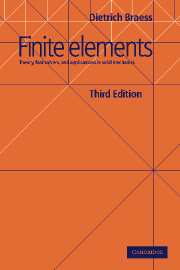Book contents
- Frontmatter
- Contents
- Preface to the Third English Edition
- Preface to the First English Edition
- Preface to the German Edition
- Notation
- Chapter I Introduction
- Chapter II Conforming Finite Elements
- Chapter III Nonconforming and Other Methods
- Chapter IV The Conjugate Gradient Method
- Chapter V Multigrid Methods
- Chapter VI Finite Elements in Solid Mechanics
- References
- Index
Preface to the German Edition
Published online by Cambridge University Press: 01 March 2010
- Frontmatter
- Contents
- Preface to the Third English Edition
- Preface to the First English Edition
- Preface to the German Edition
- Notation
- Chapter I Introduction
- Chapter II Conforming Finite Elements
- Chapter III Nonconforming and Other Methods
- Chapter IV The Conjugate Gradient Method
- Chapter V Multigrid Methods
- Chapter VI Finite Elements in Solid Mechanics
- References
- Index
Summary
The method of finite elements is one of the main tools for the numerical treatment of elliptic and parabolic partial differential equations. Because it is based on the variational formulation of the differential equation, it is much more flexible than finite difference methods and finite volume methods, and can thus be applied to more complicated problems. For a long time, the development of finite elements was carried out in parallel by both mathematicians and engineers, without either group acknowledging the other. By the end of the 60's and the beginning of the 70's, the material became sufficiently standardized to allow its presentation to students. This book is the result of a series of such lectures.
In contrast to the situation for ordinary differential equations, for elliptic partial differential equations, frequently no classical solution exists, and we often have to work with a so-called weak solution. This has consequences for both the theory and the numerical treatment. While it is true that classical solutions do exist under approriate regularity hypotheses, for numerical calculations we usually cannot set up our analisis in a framework in which the existence of classical solutions is guaranteed.
One way to get a suitable framework for solving elliptic boundary-value problems using finite elements is to pose them as variational problems. It is our goal in Chapter II to present the simplest possible introduction to this approach. In Sections 1 – 3 we discuss the existence of weak solutions in Sobolev spaces, and explain how the boundary conditions are incorporated into the variational calculation.
- Type
- Chapter
- Information
- Finite ElementsTheory, Fast Solvers, and Applications in Solid Mechanics, pp. xii - xiiiPublisher: Cambridge University PressPrint publication year: 2007



